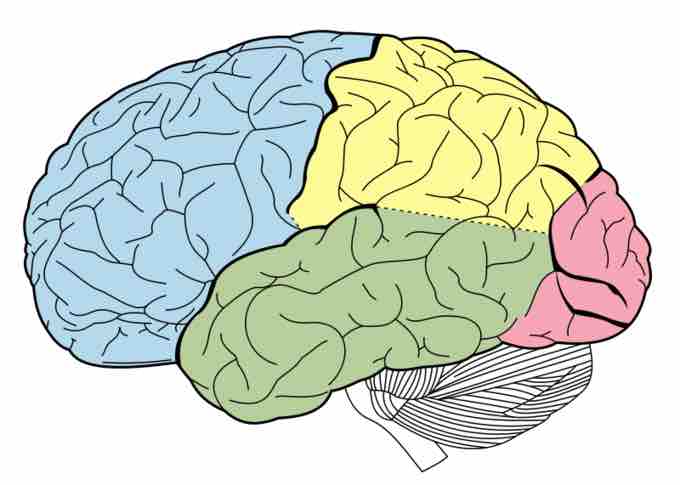Cortex
The cerebral cortex, the largest part of the mammalian brain, is the wrinkly gray outer covering of the cerebrum. While the cortex is less than 1/4" thick, it is here that all sensation, perception, memory, association, thought, and voluntary physical actions occur. The cerebral cortex is considered the ultimate control and information-processing center in the brain.
The cortex is made of layers of neurons with many inputs; these cortical neurons function like mini microprocessors or logic gates. It contains glial cells, which guide neural connections, provide nutrients and myelin to neurons, and absorb extra ions and neurotransmitters. The cortex is divided into four different lobes (the parietal, occipital, temporal, and frontal lobes), each with a different specific function.

Lobes of the brain
A diagram of the brain identifying the different lobes by color. Counterclockwise from bottom: It contains the parietal lobe (green), the occipital lobe (red), the temporal lobe (yellow), and the frontal lobe (blue).
The cortex is wrinkly in appearance. Evolutionary constraints on skull size brought about this development; it allowed for the cortex to become larger without our brains (and therefore craniums) becoming disadvantageously large. At times it has been theorized that brain size correlated positively with intelligence; it has also been suggested that surface area of cortex (basically, "wrinkliness" of the brain) rather than brain size that correlates most directly with intelligence. Current research suggests that both of these may be at least partially true, but the degree to which they correlate is not clear.
The "valleys" of the wrinkles are called sulci (or sometimes, fissures); the "peaks" between wrinkles are called gyri. While there are variations from person to person in their sulci and gyri, the brain has been studied enough to identify patterns. One notable sulcus is the central sulcus, or the wrinkle dividing the parietal lobe from the frontal lobe.

Sulci and gyri
As depicted in this diagram of brain structures, sulci are the "valleys" and gyri are the "peaks" in the folds of the brain.
Cerebrum
Beneath the cerebral cortex is the cerebrum, which serves as the main thought and control center of the brain. It is the seat of higher-level thought like emotions and decision making (as opposed to lower-level thought like balance, movement, and reflexes).
The cerebrum is composed of gray and white matter. Gray matter is the mass of all the cell bodies, dendrites, and synapses of neurons interlaced with one another, while white matter consists of the long, myelin-coated axons of those neurons connecting masses of gray matter to each other.
Grey matter and white matter
A sagittal cross-section of a human brain showing the distinct layers of grey matter (the darker outer layer) and white matter (the lighter inner layer) in the cerebrum.